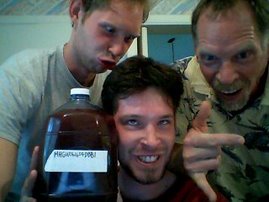12:30am - Released CO2 pressure
9:30am - Placed the bottle in the refrigerator to chill
At 11:30am, I tried to follow the advice of the initial instructions and strain the mix through a coffee filter, but the filter was not porous enough to allow the mix to flow through it in a reasonable amount of time. Alternatively, I used the bottom half of a tea infuser to strain most of the ginger out of the mix. I still felt the need to strain using more of a filter, but other attempts were unsuccessful. Perhaps a fine wire mesh would be better and more convenient. As it stands now, I have placed the liquid in the left over spring water bottle and placed it in the refirgerator. Much of the carbonation was lost with the repeated straining.
One question I have is, Exactly how much does the mix need to be strained to make it safe for consumption. My biggest worry was that consuming the drink without running it through a substantial filter would allow the ingestion of a large amount of active yeast.
I have tasted the drink in small amounts. It is decent...sort of like a cross between lemonade and ginger ale. But, as I said earlier, the drink is mainly flat.
As an experiment in fermentation, I am pleased. The conditions were obviously met to have the yeast and other nutrients react favorably.
My next run will differ mainly in the use of better tools. These will include:
- fine wire mesh for straining
- one-way valve to release CO2
- a funnel

1 comment:
I just read on another website that in most homebrew beer making, carbonation actually happens in the bottle after the active fermentation is over with. This would explain why my first ale was flat even after the period of aggressive fermentation. Since then (5 days at the time of this writing) the ale has certainly become much more carbonated.
Post a Comment